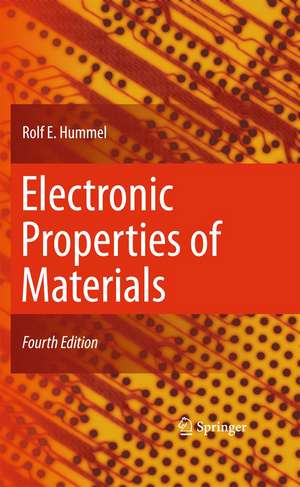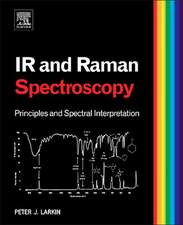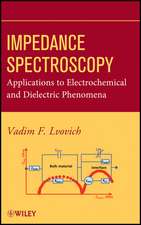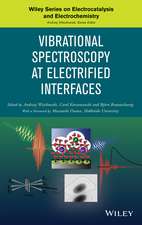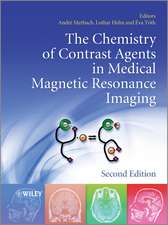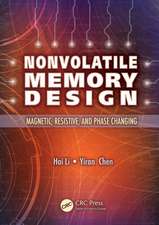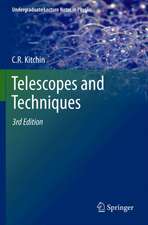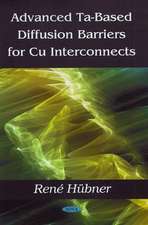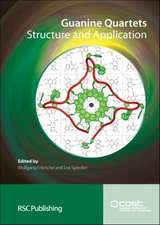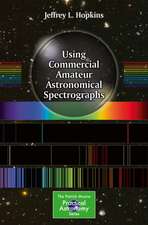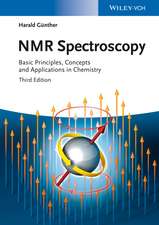Electronic Properties of Materials
Autor Rolf E. Hummelen Limba Engleză Paperback – 28 noi 2014
| Toate formatele și edițiile | Preț | Express |
|---|---|---|
| Paperback (1) | 466.87 lei 43-57 zile | |
| Springer – 28 noi 2014 | 466.87 lei 43-57 zile | |
| Hardback (1) | 543.52 lei 43-57 zile | |
| Springer – 23 iun 2011 | 543.52 lei 43-57 zile |
Preț: 466.87 lei
Nou
Puncte Express: 700
Preț estimativ în valută:
89.36€ • 97.10$ • 75.11£
89.36€ • 97.10$ • 75.11£
Carte tipărită la comandă
Livrare economică 21 aprilie-05 mai
Preluare comenzi: 021 569.72.76
Specificații
ISBN-13: 9781489998415
ISBN-10: 1489998411
Pagini: 508
Ilustrații: XIX, 488 p.
Dimensiuni: 155 x 235 x 30 mm
Greutate: 0.71 kg
Ediția:4th ed. 2011
Editura: Springer
Colecția Springer
Locul publicării:New York, NY, United States
ISBN-10: 1489998411
Pagini: 508
Ilustrații: XIX, 488 p.
Dimensiuni: 155 x 235 x 30 mm
Greutate: 0.71 kg
Ediția:4th ed. 2011
Editura: Springer
Colecția Springer
Locul publicării:New York, NY, United States
Public țintă
Professional/practitionerCuprins
Part I: Fundamentals of Electron Theory: Introduction. Wave Properties of Electrons. The Schroedinger Equation. Solution of the Schroedinger Equation for Four Specific Problems. Energy Bands in Crystals. Electrons in a Crystal.- Part II: Electrical Properties of Materials: Electrical Conduction in Metals and Alloys. Semiconductors. Electrical Properties of Polymers, Ceramics, Dielectrics and Amorphous Materials.- Part III: Optical Properties of Materials: The Optical Constants. Atomistic Theory of the Optical Properties. Quantum Mechanical Treatment of the Optical Properties. Applications.- Part IV: Magnetic Properties of Materials: Foundations of Magnetism. Magnetic Phenomena and Their Interpretation - Classical Approach. Quantum Mechanical Considerations. Applications.- Part V: Thermal Properties of Materials: Introduction. Fundamentals of Thermal Properties. Heat Capacity. Thermal Conduction. Thermal Expansion.- Appendices.- Index.
Recenzii
From the reviews of the fourth edition:
“This is an excellent book for materials and electrical engineers, as well as advanced students. This book is divided into five distinct and self-contained parts, which makes it easier for the reader to find information on a particular area of interest. … contains many applications and problems that help to bridge the gap between physics and engineering. … For practicing engineers, this would be a good reference book. It would also be useful for someone looking to gain an overall concept of device physics.” (Ishtiaque Ahmed, Optics & Photonics News, April, 2012)
“This is an excellent book for materials and electrical engineers, as well as advanced students. This book is divided into five distinct and self-contained parts, which makes it easier for the reader to find information on a particular area of interest. … contains many applications and problems that help to bridge the gap between physics and engineering. … For practicing engineers, this would be a good reference book. It would also be useful for someone looking to gain an overall concept of device physics.” (Ishtiaque Ahmed, Optics & Photonics News, April, 2012)
Notă biografică
Rolf E. Hummel is a Professor Emeritus of Materials Science and Engineering at the University of Florida, Gainesville, USA. He received his Ph.D (Dr. rer.nat.) in 1963 from the University of Stuttgart, Germany and the Max-Planck Institute for Materials Research, also in Stuttgart. He has been at the University of Florida since graduation, only interrupted by Sabbatical stays in Japan, Korea, China, New Zealand, France, Vietnam, Germany, and Colorado. His previous publications include Optical Properties of Metals and Alloys (1971), Electro-and Thermo-Transport in Metals and Alloys (ed.),(1977), the two-volume Handbook of Optical Properties (ed.), (1996), and Understanding Materials Science 2nd Ed. (2004). His books are widely appraised for their easy understandability.
Textul de pe ultima copertă
This book on electrical, optical, magnetic, and thermal properties of materials differs from other introductory texts in solid-state physics. First, it is written for engineers, particularly materials and electrical engineers, who what to gain a fundamental understanding of semiconductor devices, magnetic materials, lasers, alloys, and so forth. Second, it stresses concepts rather than mathematical formalism, which should make the presentation relatively easy to read. Third, it is not an encyclopedia: The topics are restricted to material considered to be essential and that can be covered in one 15-week semester.
The book is divided into five parts. The first part, "Fundamentals of Electron Theory," introduces the essential quantum mechanical concepts needed for understanding materials science; the other parts may be read independently of each other. Many practical applications are discussed to provide students with an understanding of electronic devices currently in use. The solutions to the numerical problems are given in the appendix.
Previous editions have been well received by students and teachers alike. This Fourth Edition has again been thoroughly revised and brought up to date to take into account the explosive developments in electrical, optical, and magnetic materials and devices. Specifically, new topics have been added in the "applied sections," such as energy saving light sources, particularly compact fluorescence light fixtures, organic light-emitting diodes (OLEDs), organic photovoltaics (OPV cells), optical fibers, pyroelectricity, phase-change memories, blue ray disks, holographic versatile disks, galvanoelectric phenomena (emphasizing the entire spectrum of primary and rechargeable batteries), graphene, quantum Hall effect, iron-based semiconductors (pnictides), etc. to mention just a few subjects.
The book is divided into five parts. The first part, "Fundamentals of Electron Theory," introduces the essential quantum mechanical concepts needed for understanding materials science; the other parts may be read independently of each other. Many practical applications are discussed to provide students with an understanding of electronic devices currently in use. The solutions to the numerical problems are given in the appendix.
Previous editions have been well received by students and teachers alike. This Fourth Edition has again been thoroughly revised and brought up to date to take into account the explosive developments in electrical, optical, and magnetic materials and devices. Specifically, new topics have been added in the "applied sections," such as energy saving light sources, particularly compact fluorescence light fixtures, organic light-emitting diodes (OLEDs), organic photovoltaics (OPV cells), optical fibers, pyroelectricity, phase-change memories, blue ray disks, holographic versatile disks, galvanoelectric phenomena (emphasizing the entire spectrum of primary and rechargeable batteries), graphene, quantum Hall effect, iron-based semiconductors (pnictides), etc. to mention just a few subjects.
Caracteristici
Widely used, course-tested text is now available in an updated Fourth Edition Introduces the elements of solid-state physics that are required to understand the coverage of electrical, optical, magnetic, and thermal properties of materials and their applications Stresses concepts rather than mathematical formalism Describes the materials basis of the next generation of electronic devices Designed for a single, 15-week semester course Supplemental and more detailed information for graduate students is marked with an asterisk Divided into five independent modules to suit different course needs Presents many end-of-chapter problems with numerical solutions in an appendix Includes supplementary material: sn.pub/extras Request lecturer material: sn.pub/lecturer-material
